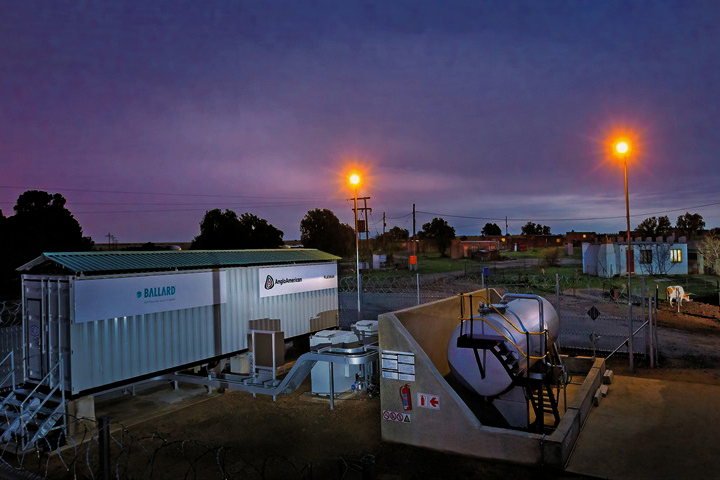It might be challenging to envision existence without electricity, but in South Africa, remote villages have been lacking a dependable source of power for an extended period. Numerous villages are not linked to the power network; owing to their considerable distance from electrical infrastructure, making a connection to the grid would prove exceedingly costly. Moreover, with a small number of users, the revenue generated wouldn’t suffice to cover the expenses needed solely for maintenance. Sadly, this shortage of electricity significantly hampers economic advancement, corporate investments, government operations, and evolution for these societies.
A quintessential example of this can be seen in the Naledi Trust community in South Africa’s Free State province. With only 34 households, attaining economic development without reliable electricity is a challenge, and unoccupied residents loitering around could result in public safety problems. To tackle this situation, the South African government initially experimented with equipping each household with solar panels. However, this effort ultimately failed; due to poverty and the high joblessness rate, the solar panels were pilfered and traded on the underground market. Committed to finding a remedy, the government launched a two-year program to devise an off-grid sustainable power answer for distant villages.
An off-grid power answer, also called an isolated or island power system, would be optimal. This approach would enable communities to be energy-supported by electricity created by a centralized local facility rather than relying on a distant power station. This move would eliminate the expenditure of constructing and sustaining infrastructure to associate with a power network hundreds of miles away. This exploration led the South African government to investigate Chung Hsin Electric & Machinery’s (CHEM) hydrogen fuel cell system. CHEM’s ME2 fuel cell mechanism can produce up to 15 kW of clean power, with a maximum of 70 kW with battery support. This would be ample to provide power to the 34 households in the Naledi Trust community. Furthermore, since fuel cell systems are large and can weigh over 300 kg, theft of the system would be extremely challenging.
CHEM’s ME2 system was excellent for furnishing dependable, clean electricity, but two hurdles lingered. First, the costs of operation and maintenance would be substantial. Second, the initial investment expense would be a deterrent, notably when juxtaposed with conventional diesel generators. To surmount these barriers, CHEM partnered with Moxa to boost their system with IIoT capabilities, revolutionizing both CHEM’s fuel system and their business model.
Minimizing Operation and Maintenance Expenses
To secure reliable, 24/7 access to electricity, regular deliveries of methanol fuel would be indispensable. Additionally, given the harsh outdoor location where the system would be installed, regular inspections for problems would be obligatory. Due to the remote aspect of being a community, the costs of arranging fuel delivery and dispatching engineers for on-site visits would be steep. Amy Liao, the Director of the Hydrogen Department at CHEM, remarked, “Conducting inspections and managing fuel delivery logistics demands significant manpower. Given that all systems are sited in remote locations, improving our maintenance metrics devoid of a network was a challenge.”
Integrating Moxa’s cellular remote I/O solution into CHEM’s fuel cell system transformed the scenario. This integration allowed real-time operational data to be sent to a control center, enabling instant detection of low fuel levels. This proved pivotal in efficiently organizing fuel deliveries as needed rather than adhering to a fixed schedule that could result in early or late deliveries. Furthermore, remote maintenance became a viable option. System status could be monitored at any point, and basic issues could be rectified remotely. Personnel were required to make on-site visits only when necessary. Enriching CHEM’s system with IIoT capabilities resulted in a 50% plunge in deployment and maintenance expenses.
Cutting Initial Capital Costs
As an eco-friendly energy source, fuel cell systems incur a substantially higher cost compared to diesel generators, posing a deterrence to numerous clients. The hefty price tag of acquiring a fuel cell system for a single remote village could complicate government decisions concerning approving such a sizable investment. However, now that CHEM’s fuel cell system was furnished with IIoT connectivity, usage could be remotely monitored. Data on power consumption, voltage, conditions, power supply duration, fuel levels, and more could be meticulously tracked from a control center. Amy Liao mentioned, “The IIoT is reshaping our business model. We are transitioning from vending a product to offering Machines-as-a-Service.” Through this business model shift, CHEM could construct enduring business affiliations where they charged based on the actual power generated and consumed, as opposed to selling the system itself. By eradicating the high entry cost, CHEM now had access to a larger pool of clientele and fresh revenue streams.
Presently, the residents of the Naledi Trust community have undergone a transformation. A dependable power supply promotes new commercial and economic endeavours, while educational and government services can continue uninterrupted. Eddy Lin, the General Manager of Moxa’s Intelligence Business Group, commented, “It is my heartfelt desire that our IIoT solutions can illuminate all the remote communities globally, fostering positive change in the world.”
To access the comprehensive case study, click here.
- Not Only for Automobiles: Discovering CANbus Technology in Various Industrial Settings - October 29, 2024
- Boost Your Network Performance: An Exciting Manual to PoE Switches! - September 10, 2024
- Understanding Gigabit Switches: Industrial vs Regular Gigabit - September 4, 2024


